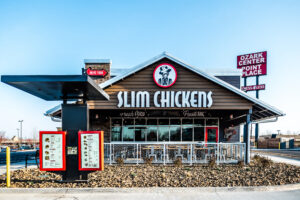
Slim Chickens’ Best Year Yet is Merely a Stage-Setter for 2024
The Chicken Chain is Now Taking Aim at 1,000 Domestic Locations

01/09/2024
Slim Chickens Has Grown By 70 Percent in The Past Three Years.
In the summer of 2019, Slim Chickens was an 84-unit brand with wide prospects. It had just secured funds from 10 Point Capital, the firm behind the growth of Tropical Smoothie Café (they exited in 2020) and, more recently, Walk-On’s and founder Brandon Landry’s offshoot second venture, Smalls Sliders.
The mark: Open 600 new locations over the next decade. Even then, as ambitious a figure as that was, namely in a category stuffed to the brim with competitors, CEO Tom Gordon knew it was merely “the first target on the wall.” Slim Chickens expected to eclipse the number. So did 10 Point Capital.
But all things considered, the fast casual had to start somewhere.
Accelerate to the present—a pandemic wedged in between—and Slim Chickens is coming off its most robust year yet. The chain opened 53 locations and believes it will debut north of 70 in 2024. Slim Chickens signed over 400 development deals across two years and experienced 70 percent growth through the last three, opening a store per week to get to the 250 or so on the map today. Fifty-four agreements were inked in Q4 alone, with operators looking to expand in Cincinnati and Dayton, Ohio; central Pennsylvania, Louisiana, Maryland, and Texas. There are 1,200-plus stores in the pipeline, the brand says.
Meanwhile, average-unit volumes closed 2023 up 13.6 percent, with its Group 1 locations, according to a recent FDD Item 19, averaging $3.864 million per location.
Slim Chickens’ U.S. net grow in 2022, 2021, and 2020, was 31, 28, and five restaurants, respectively.
It entered 10 new territories last year, including the world’s largest airport in Istanbul, Turkey, and cracked into Nevada, Wisconsin, and the University of Arkansas Fort Smith.
One final metric—same-store sales climbed 40 percent over four years.
Gordon isn’t catching his breath. Slim Chickens new goal is 1,000 domestic and 500 international restaurants, he shared with QSR. “We talk about those goals all the time,” Gordon says. “And when we hit them, I don’t know. But those are the things that our organization strives for, and we look forward to developing out those areas that will allow us to hit those numbers.”
“Not just for us,” he adds, “but for franchisees and franchisee satisfaction, and the franchisees’ ability to build their business and grow their business.”
Gordon and cofounder Greg Smart thought up Slim Chickens in the latter’s garage. In 2003, it launched in a former sushi restaurant in Fayetteville, Arkansas. It would be two years before the brand cut the ribbon on store No. 2 and 11 before it decided to franchise. Six regional deals were struck that first year (2014) and Slim Chickens entertained its share of outside suitors hoping to infuse capital into a brand that’s fandom outsized its unit count. The brand ran into 10 Point Capital at a conference and discussions began. While Slim Chickens wasn’t initially interested, the groups found common ground. COO Sam Rothschild, a former consultant for the brand who also served as SVP of operations at Applebee’s International before joining in 2014, said previously Slim Chickens was attracted to 10 Point Capital’s history in scaling franchise concepts. Or put differently, the brand sought a partner who could drive impact beyond financing.
The capital backing enabled Slim Chickens to speed up the process. It could recruit more, hire additional talent, and operate from a less budget-constrained position when it came to payroll and travel, and other realities of trying to become a franchisor of choice throughout the country and beyond. Yet to an earlier point, one thing 10 Point Capital didn’t need to do was manufacture interest in Slim Chickens. It had already grown from a little more than a dozen units in 2014 to the 84 at time of investment. The following year, it had 45 franchise commitments. That would balloon to 112, 180, 235, 334, and 477 over the ensuing five years.
Interested parties all observed similar ticks, regardless of zip code—Slim Chickens’ Southern DNA and broad menu, from 17 house-made dipping sauces to tenders to chicken and waffles to mac and cheese bowls to fried mushrooms, okra, and pickles, didn’t struggle to grab buzz in perhaps the hottest battleground in all of quick service—from 2010 to 2023, according to the U.S. Department of Agriculture, annual consumption of chicken in the U.S. increased from 82.8 average pounds per capital to 101.7 (projection; it was 100.6 in 2022). Beef declined in that same window from 59.3 to 57.9.
Gordon says change within chicken foodservice has stabilized a bit of late, but the last decade was revolutionary.
“I think we’ve been fortunate to be able to compete, stand out, and grow, in the face of several competitors that have done the same,” he says. “There’s lots that are smaller and regional and there’s room for everybody. I’m not against any brand. But we want to make sure that we continue to deliver on the promises we make to our franchisees and our guests that are going to get the quality, great products, with a smile, every time they come into the restaurants. That’s our mantra.”
Slim Chickens’ ascension forced it to become, and stay, agile. Growth is flowing through non- and traditional outlets, in the U.S. and overseas (namely the U.K.). There are conversions, stadiums, train stations, airports, malls, campuses, and on it goes. The brand listens to franchisees and responds.
Coming out of the pandemic, about 90 percent of the fleet were standalone drive-thru units, with some outliers—endcaps, inline locations on college campuses, and military bases.

Gordon says Slim Chickens will continue to “do a lot of those,” speaking of drive-thrus. However, there’s undoubtedly a rolling focus to ensure the brand is presenting options to franchisees who want to grow with the brand, and for those who need a flexible entry point. One thing Gordon adds that Slim Chickens kept working on is making sure builds are friendly to third-party couriers trying to pick up food for delivery. “Make it easy for them to get in and out of our stores,” he says, “because that channel continues to grow.”
The brand’s continued U.K. growth provided strong learnings as well, since the entirely of that effort unfolded through in-line restaurants. Gordon says Slim Chickens can take what works there and deploy them to some of the biggest U.S. cities in the future.
Slim Chickens had had to make a few tweaks to its menu overseas and deal with different media regulations, but, generally, the observation isn’t all that different than what the brand experienced in its early days. “It’s about the same,” Gordon says. “People love the food. They love the product.”
“… When it all comes down to it with restaurants,” he continues, “you’ve got to serve great food and you’ve got to have great service, and you’ve got to do it with a smile. The fundamentals remain the same.”
Gordon says he feels fortunate to be at the controls of a brand that’s main directive is execution and evolution, not trying to sell a story or product that needs to be finessed. It’s helped insulate Slim Chickens during what’s admittedly been a rocky landscape. Permitting and construction are slower than they used to be. Interest rates have soared. So the ability to control and adjust to timelines has become a full-time occupation. As has learning to manage a P&L where rent doesn’t choke the business and operators understand how to deal with the dramatic jumps in labor. “I think we’re still, what is it, maybe two years now, learning how to live in the post-COVID world. We’ve got to give up on that excuse at some point,” Gordon says. “… It seems like every five or six years you have to retool and figure out how to take on the next five or six years. That’s the position for us now.”
At this stage in his leadership, Gordon says what he can’t ever do is limit opportunity. Slim Chickens’ role as a franchisor will be to remain operator centric no matter how large it grows, or how fast it gets there. Right now, the top aim is to take care of the current year pipeline with an eye on 2025.
The company has added tools as it’s expanded. It’s become better at site selection, architecture, and organizing how restaurants sit on lots and how drive-thru radiuses and parking lots work, etc., Gordon says. It’s become more efficient in plotting out markets and knowing where to go to maximize efficiency anywhere in the country. “Those are getting better as a function as learning,” he says. “It’s a function of recruiting high-caliber talent who knows how to do this work. And it’s a function of collaborative efforts with quality franchisees where we can work through issues and problems and opportunities and get to a result that makes sense for everybody together. That’s the magic and beauty of franchising and that’s why we do it.”
The brand evolved on the tech side, too, with kiosks, the present development of AI at the drive-thru, a curated Slim Chickens app, and online ordering platform.
The future is wide open: Slim Chickens plans to fill the U.S. as well as both sides of the Atlantic in Ohio, Pennsylvania, New York, Virginia, West Virginia, Canada, Germany, United Kingdom, the European Union, Turkey, and the GCC.
“People want it. We’ve sold out a lot of the country. There’s territory left,” Gordon says. “But the job now is really to put the stores on the ground and to make sure the franchisees are happy with how it’s gone.”
Read the Full Story in QSR Magazine here: LINK

